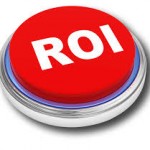Determining the ROI of Forecasting Systems
 Estimating the Return-On-Investment (ROI) for a new demand forecasting system can be difficult and requires an appreciation of the downstream impacts of more accurate forecasts.
Estimating the Return-On-Investment (ROI) for a new demand forecasting system can be difficult and requires an appreciation of the downstream impacts of more accurate forecasts.
An improved forecasting and planning system involves new software and highly specific consulting services to produce the desired results. Depending upon the level of sophistication, projects can range from $40K to $80K for software and consulting services.
- Software – consists of a user-configurable statistical forecasting engine that creates models using historical data stored in an active (constantly updated) demand repository. These models are used to produce highly granular future baseline forecasts. Once baseline forecasts are made available, a collaborative process is then leveraged to optimize the overrides from various stakeholders.
- Consulting services – consists of the technical implementation, configuration and training on the software itself, along with project design. The project design should include best practices for process changes, process management and forecasting/planning methodologies.
The benefits derived from a forecasting system can be both hard (clear bottom- line savings) and soft (more difficult to justify cost savings), as well as overall process improvements.
Hard cost savings
- Downstream finished goods inventory reduction from forecast accuracy improvement alone would include a one-time savings from the decrease in inventory, as well as a recurring savings of the carrying cost of the reduced inventory. Estimates range depending on your type of business.
In a pure make-to-stock or distribution company the downstream inventory reduction could range from 10% to 30% since forecasting inaccuracies typically drive around 75% of the required safety stock.
In a hybrid company (part make-to-stock and part make-to-order) the downstream inventory reduction could range from 5% to 10% depending on the balance of MTS and MTO.
In a pure make-to-order company the collaborative component of forecasting drives nearly all the savings in a range from 5% to 15%.
- Customer service improvements (improved fill rates and on-time deliveries) will create hard savings if the company has service level contracts to supply their customers. Estimates for these types of savings are difficult to estimate without specific internal company data.
Soft or indirect cost savings
- Forecast process automation will reduce the time spent on creating and managing the overall forecast process. However, it rarely results in a hard labor cost savings due to the redeployment of staff.
- Operational efficiency gains from planning and scheduling improvements will be driven by a more accurate, dependable and sometimes more detailed forecast.
- More predictable financial planning will result from a more accurate forecast as well as consensus (group commitment) planning driven by the collaborative process changes.
- Raw material management savings generated by a more accurate upstream finished goods forecast can be significant. Material procurement practices and supply chain planning can be dramatically improved. Plus, raw material inventory reductions and the associated inventory carrying costs can be a fraction of the finished goods inventory savings depending upon how much the manufacturing process adds value to the finished product.
If pure forecast accuracy improvement from the forecasting software is expected to drive most of the cost savings and determine the ROI and payback period, an upfront overview analysis may need to be done to estimate the accuracy improvement.
Most companies making the decision to move to a new forecasting/planning system are primarily driven by:
- Obvious forecast accuracy challenges
- A highly variable process that requires too much local knowledge of the company’s products. In this case, the loss of a knowledge worker can be critical.
- Lack of time and knowledge to produce the detail-level forecasts required to support a more efficient manufacturing or distribution system
- Downstream inventory problems that are clearly driven by forecasting problems
- An attempt to drive more cooperation and ownership between sales and operations through a consensus-based forecast
If a rigorous ROI justification is required to move to a new forecasting/planning system, my experience has shown that it’s generally due to a lack of understanding by decision makers of the downstream impact of a more accurate and consistent forecast. This lack of understanding often leads to a lack of urgency in pursuing a new system, which can have a major effect on an organization’s profitability.